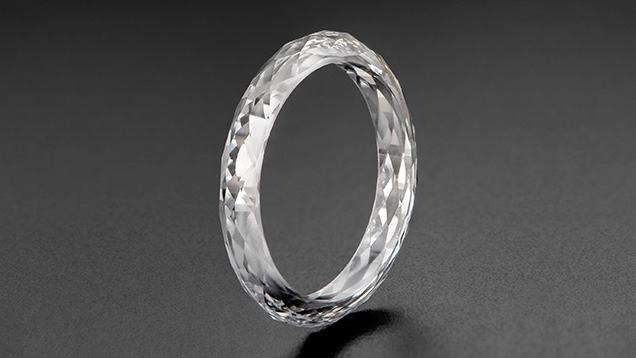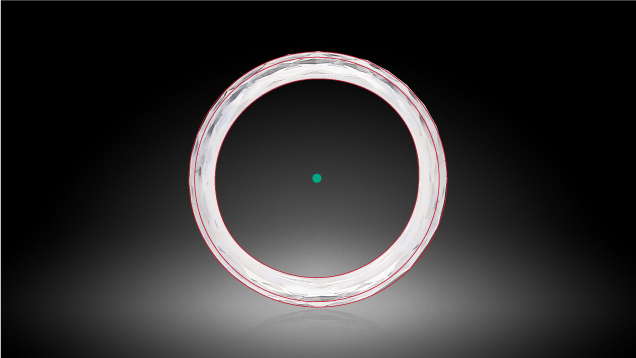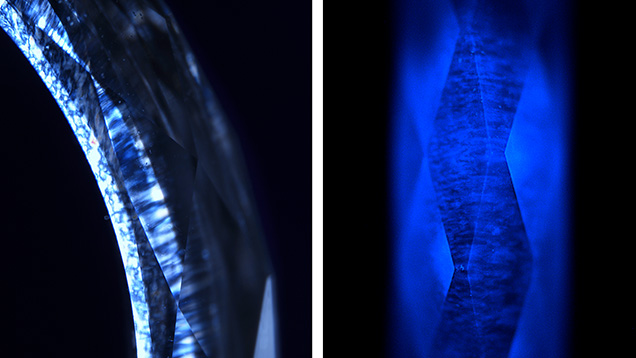Solid Laboratory-Grown Single-Crystal Diamond Ring
August 4, 2023

Carved single-crystal diamond rings are rare, with few examples to reference (see Spring 2020 Lab Notes, pp. 132–133). But with advancing technology in the laboratory-grown diamond industry, the creation of solid faceted diamond rings is now a reality. Recently submitted to the New York laboratory was a 4.04 ct single-crystal laboratory-grown diamond ring (figure 1). The 3.03 mm thick band had an inner diameter of 16.35–16.40 mm and an outer diameter of 20.32–20.40 mm. The ring was produced by Dutch Diamond Technologies in collaboration with the Belgian jewelry store Heursel, established in 1745.

This laboratory-grown diamond ring was cut from an 8.54 ct plate grown by chemical vapor deposition (CVD). Laser cutting produced a near-perfect circular ring, as demonstrated using digital imaging analysis to measure its inner and outer circumferences (figure 2).
Manufacture of a solid single-crystal diamond ring is a very complex and challenging process. Once material is removed from the crystal, very fine fractures and imbalanced strain can have severe consequences and the ring can shatter. Processing can take more than six months. Creating the single-crystal laboratory-grown ring involved about 1131 hours of processing (including pre-grinding) in the Dutch town of Cuijk, followed by 751 hours of polishing in Belgium.
Spectroscopic analysis revealed it is a type IIa diamond (no detectable nitrogen), and no hydrogen-related peaks were detected at 3107 or 3123 cm–1. Photoluminescence spectroscopy revealed very interesting vacancy-related defects indicative of complex growth methods. A very strong emission from the silicon-vacancy (SiV–) defect was observed with 633 nm laser excitation; this is a very common feature used to identify CVD-grown diamond. The conclusion was that this ring had not undergone post-growth treatment; nevertheless, it was notable that the ring showed relatively low nitrogen-related defects such as NV centers and H3 along with no detectable 468 nm peak or the 596/597 nm doublet. P. Martineau et al. (“Identification of synthetic diamond grown using chemical vapor deposition (CVD),” Spring 2004 G&G, pp. 2–25) observed this doublet with a 514 nm laser. Also of note, there were no H3 or 468 nm centers observed with 457 nm laser excitation.

Strong birefringence was observed using cross-polarized light under microscopic analysis, with an unusual radial pattern (figure 3, left) signifying unique growth conditions compared to typical CVD diamonds available in the market today. The deep ultraviolet illumination of DiamondView imaging (figure 3, right) confirmed these unusual growth features with a lack of post-growth fluorescence colors such as green produced by the H3 center.
The solid laboratory-grown diamond ring was studied by GIA and specified with a VVS2 clarity based on dark non-diamond carbon pinpoint inclusions (growth remnants typical of CVD-grown diamonds) with good polish (polishing on the interior surface of the ring precluded very good). Although the ring is a near-perfect circle (figure 2), symmetry was considered not applicable. The diamond has a high color based on GIA’s color grading scale. The ring was laser inscribed “Laboratory-Grown” on a side facet.
The quality and size of this solid diamond ring (see the video clip below) are a great example of the advancing technology in laboratory-grown diamonds and changing trends in the jewelry industry. This is the first time a GIA laboratory has examined a colorless diamond ring fashioned entirely from a laboratory-grown diamond.
Paul Johnson is manager of analytics, Stephanie Persaud is a research associate, and Madelyn Dragone is an analytics technician, at GIA in New York.
.jpg)


